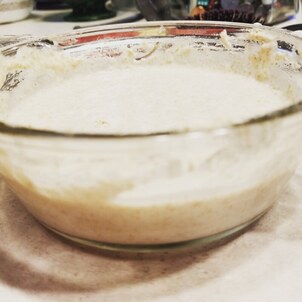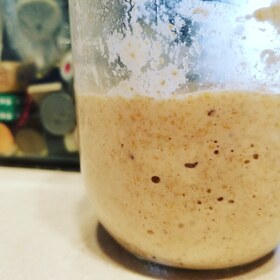 My first full week of quarantine, I welcomed the birth of Quaran-Tina, my second attempt at a sourdough starter. Long time readers will remember that the last sourdough starter I did was a failure, and I don’t know if it was my fault or not. Quaran-Tina is going to help prove to me if I’m the problem, or if Tartine Bread is the problem. I am again turning to this tome that is often referred to as the bread bible for guidance. Feeding One - 3/30/20 I have to say that I’m pretty impressed with the amount of bubbleage that Tina created for herself off of just two days of fermentation. I skimmed off a good amount of it to find a lot of yeasty water was underneath the bubbled up concoction, but I think that’s going to be okay. I am not going to go for precise measurements on my feedings like I did last time. I gave her about a cup of flour and added water until it reached a thick batter-like consistency.  … About a month Later I fed Tina every two days after that first feeding because I frankly forgot to do it every single day. It turns out that may not have been the worst idea I ever had. After transferring her into a mason jar rather than a bowl, I could see that the fermentation was occurring at a good rate. ….Many Feedings Later 5/26/20 Woops. I had intended to keep a very detailed log of my starter’s progress, but at this milestone of almost two months of feedings, I am finally engaging in sourdough projects now that I am confident in the rise and fall of Quaran-Tina. She’s a living thing in my kitchen, and she is providing me with a great deal of comfort in the current state of the world. I like to watch her grow in her big new jar. I like to make new things out of her discard and her many cut off portions that I ripen with a separate feeding. We’ve currently used Tina to produce sourdough english muffins, crackers, and tortillas. Each project has revealed something different about sourdough that I did not understand prior to giving literal months of my life to a big jar full of fermenting flour and water. The magic of the thing has built civilizations, and now it's keeping me company during a dark period of human history. It’s no wonder that bread has been with humanity since we started cultivating rain. Sure, it's useful for its nutritional value, but the actual process of growing sourdough has an emotional component to it as well that ties the cook to their creation. I don’t think I’ve referred to Quaran-Tina as Quaran-Tina since that first week. Every time I walk into the room, it's just Tina. I address the jar by name, praise it when it gets a good rise the day after a feeding. My husband still works, so there are days I do more talking with my starter and my cat than a human being. Should I be worried about that? Nah. Today’s project with a portion of Tina’s discard is pretzels. It’s hot as hell in Green Bay (Read, 84 degrees fahrenheit. I am a polar bear), and while I don’t appreciate the amount of heat that my stove generates in my apartment, I appreciate what I create. So I took the discard portion of my sourdough starter to begin the process of making sourdough pretzels via the King Arthur Flour recipe. My first few attempts at a pretzel twist were ugly at worst, adorably bad at best. It took me several tries to figure out how to properly roll out the sections with my hands. I hadn’t played with playdough in years, after all, so the technique of creating a dough snake had been lost to time. My second tray came out much more attractive than the first, and the baking went well. It was a much faster rising time than the sourdough english muffins I made via the Tartine Bread cookbook recipe which took two days of dough fermentation, beginning with the leaven and poolish and ending with a final rise of the whole dough in the fridge the night before griddling the muffins. It was, however, a success. This will be discussed more when our cookbook redemption tour gets underway in the next few weeks. Quaran-Tina has made my pandemic experience easier to handle in a variety of ways. The act of cultivating a sourdough starter alone has brought me joy, and what I create with it has provided cheaper, more nutritious sustenance for my husband and I than the processed baked goods we might otherwise buy at home. It wasn’t so long ago that I said this virus makes us all cooks, and I maintain that I would not be the bread baker I am today without what the virus has done to my life. I’ve had daydreams of telling my kids the story of this sourdough starter when I pass it on as an heirloom. It’s a story that I imagine will take place all across this country in about twenty years or so, when all of us bread baking millennials have finally given in to the pressures of becoming parents and share our experiences with a new generation. There is still a likelihood we will develop even more shared cooking experiences that will become our Great Depression stories. I will come out the other side of this thing a better, happier cook. I have already developed a deeper understanding of what I really like to do in the kitchen and outside of it as a result, and many of the things I once viewed as an unnecessary, time wasting chore now feel joyous. We’re going to grow so many things. Sourdough starters, plants, and ourselves.
0 Comments
Leave a Reply. |
The Mission An idea born in Normal, Illinois, Eating Normal hopes to chronicle the eating Experiences of a Red bird. Pledge monthly to our patreon! Archives
May 2024
Categories
All
|
 RSS Feed
RSS Feed